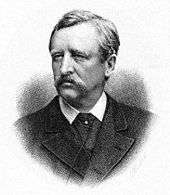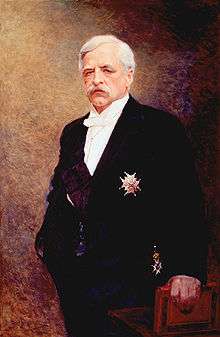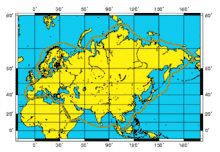Adolf Erik Nordenskiöld
Nils Adolf Erik Nordenskiöld (18 November 1832, Helsinki, Finland – 12 August 1901, Dalbyö in Södermanland, Sweden) was a Finland-Swedish aristocrat, geologist, mineralogist and Arctic explorer. He was a member of the prominent Finland-Swedish Nordenskiöld family of scientists and held the title of a friherre (baron).
Adolf Erik Nordenskiöld | |
|---|---|
 Adolf Erik Nordenskiöld | |
| Born | 18 November 1832 |
| Died | 12 August 1901 (aged 68) |
| Nationality | Finland, Sweden |
| Alma mater | Imperial Alexander University of Finland |
| Known for | Vega Expedition through the Northeast Passage |
| Awards | Founder's Medal of RGS (1869) Constantine Medal (1878) Vega Medal (1881) Murchison Medal (1900) |
| Scientific career | |
| Fields | Geology, mineralogy, cartography |
| Institutions | Naturhistoriska Riksmuseet |
Born in the Grand Duchy of Finland at the time it was a part of the Russian Empire, he was later, due to his political activity, forced to move to Sweden, where he later became a member of the Parliament of Sweden and of the Swedish Academy. He led the Vega Expedition along the northern coast of Eurasia in 1878–1879. This was the first complete crossing of the Northeast Passage. Initially a troubled enterprise, the successful expedition is considered to be among the highest achievements in the history of Swedish science.

Nordenskiöld family
The Nordenskiölds were an old Finno-Swedish family, and members of the nobility. Nordenskiöld's father, Nils Gustaf Nordenskiöld, was a prominent Finnish mineralogist, civil servant and traveller. He was also a member of the Russian Academy of Sciences.
Adolf Erik was the father of Gustaf Nordenskiöld (explorer of Mesa Verde) and Erland Nordenskiöld (ethnographer of South America) and maternal uncle of Nils Otto Gustaf Nordenskjöld (another polar explorer). Nils Otto Gustaf Nordenskjöld's parents were cousins — Otto Gustaf Nordenskjöld (born in 1831 in Hässleby, Sweden) and Anna Elisabet Sofia Nordenskiöld (born in 1841 in Finland), who was the sister of Adolf Erik Nordenskiöld. The Swedish side of the family used the spelling "Nordenskjöld", whereas the Finnish side of the family used the "Nordenskiöld" spelling.
Early life and education
Nordenskiöld was born in 1832 in Helsinki, the capital of Finland, but he spent his early youth on the family estate in Mäntsälä. He went to school in Porvoo, a small town on the south coast of Finland. He then entered the Imperial Alexander University in Helsinki in 1849 where he studied mathematics, geology, and applied himself especially to chemistry and mineralogy.[1] He received his master's degree in 1853. Two years later he published his doctoral dissertation, entitled "Om grafitens och chondroditens kristallformer" ("On the crystal forms of graphite and chondrodite").
Upon his graduation, in 1853, Nordenskiöld accompanied his father to the Ural Mountains and studied the iron and copper mines at Tagilsk; on his return he received minor appointments both at the university and the mining office.[1]
Political activity and exile
Having studied under Runeberg he belonged to Liberal, anti-tsarist circles that agitated for Finland's liberation from Russia by the Swedes during the Crimean War; and an unguarded speech at a convivial entertainment in 1855 drew the attention of the Imperial Russian authorities to his political views, and led to a dismissal from the university.[1]
He then visited Berlin, continuing his mineralogical studies, and in 1856 obtained a travelling stipend from the university in Helsinki and planned to expend it in geological research in Siberia and Kamchatka. In 1856, Nordenskiöld was also appointed Docent in Mineralogy at the university. In 1857 he aroused the suspicion of the authorities again, so that he was forced to leave Finland, practically as a political refugee, and was deprived of the right of ever holding office in the university of Finland.[1] He fled to Sweden.
In 1863 he married Anna Maria Mannerheim, the aunt of Carl Gustaf Emil Mannerheim.
Settling in Stockholm, and Arctic exploration
_-_Nationalmuseum_-_18399.tif.jpg)
Georg von Rosen (1886)
Nordenskiöld settled in Stockholm, and soon he received an offer from Otto Torell, a geologist, to accompany him on an expedition to Spitsbergen. To the observations of Torell on glacial phenomena Nordenskiöld added the discovery at Bell Sound of remains of Tertiary plants, and on the return of the expedition he received the appointment of a curator and Director of the Mineralogical Department of the Swedish Museum of Natural History[1] (Naturhistoriska Riksmuseet) and a professorship in Mineralogy at the Swedish Academy of Sciences. He was also awarded the 1869 Royal Geographical Society's Founder's Gold Medal.[2]
Nordenskiöld's participation in three geological expeditions to Spitsbergen, followed by longer Arctic explorations in 1867, 1870, 1872 and 1875,[3] led him to attempt the discovery of the long-sought Northeast Passage. This he accomplished in the voyage of the SS Vega, navigating for the first time the northern coasts of Europe and Asia. Starting from Karlskrona on 22 June 1878, the Vega doubled Cape Chelyuskin in the following August, and after being frozen in at the end of September near the Bering Strait, completed the voyage successfully in the following summer. He edited a monumental record of the expedition in five volumes, and himself wrote a more popular summary in two volumes.[1]
On his return to Sweden he received an enthusiastic welcome, and in April 1880 was made a baron and a commander of the Order of the North Star.[1]
In 1883, he visited the east coast of Greenland for the second time, and succeeded in taking his ship through the great ice barrier, a feat attempted in vain during more than three centuries.[1] The captain on the Vega expedition, Louis Palander, was made a nobleman at the same time, and took the name Palander af Vega.
In 1893, Nordenskiöld was elected to the 12th chair of the Swedish Academy.
Nordenskiöld published in 1896 "About Drilling for Water in Primary Rock" (Swedish: "Om borrningar efter vatten i urberget").[4]
In 1900 he received the Murchison Medal from the Geological Society of London.[5] He was nominated for the first Nobel Prize in Physics.[6] but died in 1901 before the prizes were awarded.
A historian of early cartography
As an explorer, Nordenskiöld was naturally interested in the history of Arctic exploration, especially as evidenced in old maps. This interest in turn led him to collect and systematically study early maps. He is today remembered for two substantial monographs, which both included many facsimiles, on early printed atlases and geographical mapping and medieval marine charts, respectively the Facsimile-Atlas to the Early History of Cartography (1889)[7] and Periplus (1897).[8]
He left his huge personal collection of early maps to the University of Helsinki, and it was inscribed on UNESCO's Memory of the World Register in 1997.[9]
Expeditions

- In 1858, 1861, and 1864 he went with expeditions to Spitsbergen, and in 1868 he went in a small vessel farther north than any vessel had ever been in the Eastern hemisphere. In 1861 he took part in Torell's second Spitsbergen expedition and in 1864 he led the expedition promoted by the Royal Swedish Academy of Sciences.
- In 1870, he visited Greenland and in 1871 went again to Spitsbergen and stayed there all winter, nearly starving to death.
- In the expeditions of 1872 and 1875, he headed a well-organized expedition in the iron steamer Sofia, and reached the highest northern latitude (+81° 42 min) then attained in the eastern hemisphere.
- In 1875, he went to the Yenisei River in Siberia, in a small vessel, which he sent back while he went up the river and returned home by land. The next year he went to the United States and was a juror at the Centennial Exhibition.
- In 1878 he sailed around the north coast of Asia, returning home by way of the Bering Strait, being the first to make the whole length of the Northeast passage. This he accomplished in the voyage of the Vega, navigating for the first time the northern coasts of Europe and Asia. Starting from Karlskrona on 22 June 1878, the Vega doubled Cape Chelyuskin in the following August, and after being frozen in at the end of September near the Bering Strait, completed the voyage successfully in the following summer.
- In 1882–1883 – 2nd Dickson Expedition ("Den andra Dicksonska Expeditionen till Grönland"[10]), he took the vessel "Sofia" to the Disko Bay where, together with three Saami, he made an expedition to the inland ice sheet. He expected the interior of Greenland to be ice-free and perhaps covered in forests. Nordenskiöld quickly had to give up due to technical problems, but the Saami penetrated 230 kilometres eastward before returning. On the east coast of Greenland, the expedition penetrated the great ice barrier—as the first after 300 years of attempts—and landed at Ammasalik (Kung Oscars Hamn) 65° 37' N, i.e., only slightly to the north of where Wilhelm August Graah was forced to turn his Umiak expedition round in 1830.
Honours
- Nordenskjold Archipelago, an island group in the Kara Sea, off the Siberian coast.
- Laptev Sea had been originally named "Nordenskiöld Sea" (Russian: мо́ре Норденшельда), after this Arctic explorer.
- Nordenskiöld Fjord in Peary Land, Greenland
- Nordenskiöld Bay, Novaya Zemlya
- Nordenskiold Glacier, East Greenland
- Nordenskiold Glacier, Northwest Greenland
- Nordenskiold Glacier, West Greenland
- Nordenskiöld Glacier (Novaya Zemlya), a group of four glaciers:
- Nordenskiöldbreen glacier in Svalbard
- Nordenskiöld Bay in Svalbard.
- Nordenskiöld crater on Mars
- Nordenskiöld was the main motif for a Finnish commemorative coin of 2007, the €10 Adolf Erik Nordenskiöld and Northeast Passage commemorative coin. The issue celebrated the 175th anniversary Nordenskiöld's birth and his discovery of the Northeast Passage.
- Nordenskjöldinkatu (Nordenskjöld street), a street in Helsinki, Finland
See also
Notes
-

- "List of Past Gold Medal Winners" (PDF). Royal Geographical Society. Archived from the original (PDF) on 27 September 2011. Retrieved 24 August 2015.
- Popular Science, August 1875, retrieved 27 May 2014
- Om borrningar efter vatten i urberget, A. E. Nordenskiold, Geologiska Föreningen i Stockholm Förhandlingar, 1896.
- "The Geological Society of London". The Times (36070). London. 20 February 1900. p. 5.
- "Nomination Database". www.nobelprize.org.
- Adolf Erik Nordenskiöld, Facsimile-Atlas to the Early History of Cartography with Reproductions of the Most Important Maps Printed in the XV and XVI Centuries, trans. Johan Adolf Ekelöf (Stockholm, 1889; reprinted, New York: Dover, 1973).
- Adolf Erik Nordenskiöld, Periplus: An Essay on the Early History of Charts and Sailing Directions, trans. Francis A. Bather (Stockholm: P. A. Norstedt, 1897).
- "The A.E. Nordenskiöld Collection". UNESCO Memory of the World Programme. 2008-06-05. Archived from the original on 2009-08-05. Retrieved 2009-12-15.
- Nordenskiöld, A.E. (1885). Den andra Dicksonska Expeditionen till Grönland, dess inre isöken och dess Ostkust utförd år 1883 under befäl af A. E. Nordenskiöld [The second Dickson Expedition to Greenland, its inner Ice Desert and its East Coast conducted 1883 under command of A. E. Nordenskiöld] (in Swedish). Stockholm: F. & G. Beijers Förlag.
- IPNI. Nordensk.
External links
| Wikimedia Commons has media related to Adolf Erik Nordenskiöld. |
| Wikisource has the text of a 1920 Encyclopedia Americana article about Adolf Erik Nordenskiöld. |
- Works by Adolf Erik Nordenskiöld at Biodiversity Heritage Library

- Works by Adolf Erik Nordenskiöld at Open Library

- Works by Adolf Erik Nordenskiöld at Project Gutenberg
- Works by or about Adolf Erik Nordenskiöld at Internet Archive
- Petri Liukkonen. "Adolf Erik Nordenskiöld". Books and Writers
- The A. E. Nordenskiöld Map Collection at the National Library of Finland
- Digitized samples from Nordenskiöld's map collection
- The A. E. Nordenskiöld Collection at UNESCO's "Memory of the World" site
| Cultural offices | ||
|---|---|---|
| Preceded by Anders Anderson |
Swedish Academy, Seat No 12 1893–1901 |
Succeeded by Gustaf Retzius |